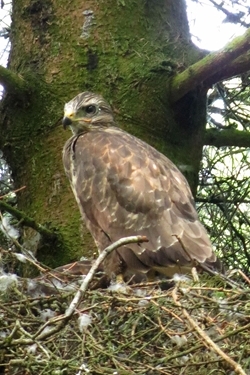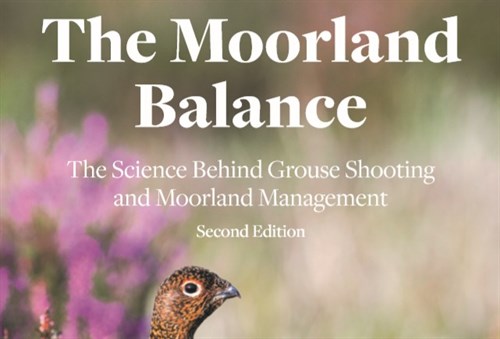Key points
- This paper studied the collective impact of buzzard predation on grouse at Langholm Moor.
- Nest cameras, prey remains and pellet analysis were used together to study what buzzards were eating in the breeding season and over winter.
- 13 breeding pairs of buzzards were hunting over the moor in spring, along with an estimated 47 non-breeding adults, totalling 73 buzzards hunting on the moor in the breeding season. 55 to 65 were estimated to hunt over the moor in winter.
- The number of grouse eaten by each individual buzzard was low, but with many buzzards hunting on the moor, the total number eaten could be considerable.
- During the breeding season, buzzards ate 5-11% of the available adult grouse and 2-5% of the chicks, and in winter ate 7-11% of adult grouse.
- The effect of buzzard predation can impact grouse numbers, assuming that buzzards kill the grouse they eat rather than scavenging already dead birds.
Background
 There is an ongoing conflict between birds of prey and management for driven grouse shooting. The potential effect of some raptor species such as hen harriers and peregrines on grouse numbers has been well studied, but the impact of predation by others is little studied.
There is an ongoing conflict between birds of prey and management for driven grouse shooting. The potential effect of some raptor species such as hen harriers and peregrines on grouse numbers has been well studied, but the impact of predation by others is little studied.
Historical killing led to the extinction of the common buzzard in some areas of the UK, but the species has been protected since 1954 by the Protection of Birds Act, and in recent years it has recovered in population numbers and range. This increasing presence has brought them into conflict with some gamebird interests, but whether predation by buzzards can affect grouse populations was not known.
This study looked at buzzard numbers and diet on Langholm Moor to understand their possible impact on the red grouse population.
What they did
Buzzard number
The authors estimated the number of buzzards that were feeding on the study site both in the breeding season and the winter. Breeding pairs nesting on the site were observed, and those nesting just outside Langholm Moor but hunting over it were accounted for. Many non-breeding adults are likely to have been present as well, and this was estimated using published figures on the proportion of the buzzard population that breeds each year. Knowing how many breeders were on the moor allowed an estimate of how many non-breeders were probably also present.
Buzzard diet
The scientists studied the diet of buzzards on Langholm Moor with several methods. They used nest cameras to record the prey that adults delivered to their chicks as well as collecting the remains of prey items from around the nest or roost. Birds of prey also produce pellets of material they cannot digest such as fur, feathers, bones or wing cases. These give an indication of what was eaten, and they were collected from around the nests and roosts in the breeding season, and roosts in winter. These methods were compared to see how much influence the assessment technique had on the results.
The scientists also carried out controlled feeding trials on four captive buzzards. They fed the birds a known diet, then studied the pellet composition to understand better the detectability of different prey species from the pellets, compared to what had been eaten. This helped them to analyse the results gathered on wild bird diet.
Calculations were made of the daily food requirements for each individual buzzard, accounting for its gender, age, and whether it was also providing for chicks. This gave total food requirements for the population of buzzards the moor was supporting.
The results of these calculations could then be combined with the proportion of buzzard diet that was found to have been made up of grouse chicks or adults that was found in the first part of the study to estimate the total amount of grouse eaten.
What they found
Buzzard number
12 pairs of buzzards bred on the study area each year. This density was used to estimate the number of pairs that would be nesting in the area immediately surrounding Langholm Moor, for whom a portion of their hunting area would be on the moor. This equated to an extra pair, so a total of 13 pairs feeding over the moor was used.
Published studies show that around 35% of the buzzard population in the UK breeds each year, so using the breeding numbers gives an estimate that an additional 47 non-breeding adults would also be hunting in the area, giving a total of 73 adult birds in the breeding season.
In winter, buzzard sightings suggested that there were 55 buzzards on the moor in 2013/14 and 65 in 2014/15.
Buzzard diet
The feeding trials showed that, where gamebirds were known to have been eaten, around half of the pellets produced contained feathers. When voles were eaten, almost all pellets (26/27) contained evidence of this (bones, fur, etc). These proportions were used to adjust the results from the field studies of pellets. The different methods to study buzzard diet gave different results for how much grouse had been eaten, with the grouse making up between 0% and 6.6% of their diet.
The percentage of buzzard diet found to consist of grouse using the various methods is shown in the table below. The results varied from year to year, so the range of findings across the years is shown. The lowest figure during the breeding season was 0% – no grouse items in the buzzards’ diet in 2011 as recorded by cameras – and the highest was around 5%, estimated from prey remains also in 2011. In winter, pellet analysis was the only method used, and this showed 3.4% of buzzard diet in the first and over 6% in the second winter of the study was made up of grouse.
| |
|
Adult grouse |
Grouse chicks |
Breeding
season |
Cameras |
0-3% |
0-0.4% |
| Prey remains |
2-5% |
0.3-0.8% |
| Pellets (adjusted) |
2-4% |
0.2-0.8% |
| Winter |
Pellets (adjusted) |
3-6% |
N/A |
The estimated number of grouse adults and chicks that were eaten was calculated for the different methods and averaged to estimate the number that were eaten on Langholm Moor each year. During each of the three breeding seasons (April-July 2011-2013), it was estimated that buzzards consumed between 73-141 adult grouse and 77-185 chicks. During two non-breeding seasons (August-March 2011-2013), they are thought to have eaten 242-400 grouse. The original paper contains more detailed information of the results from different years and an indication of the confidence held in them.
What does this mean?
The impact that birds of prey can have on grouse populations is a controversial issue. Much research has been carried out into the effect of hen harrier and peregrine predation, but the possible additional effect of buzzards is comparatively under-researched.
The results of this study estimate that each breeding pair of buzzards with their chicks would eat up to five adult grouse, and up to six chicks each breeding season, therefore having only a small impact on the population. However, although individually this is lower than the estimated impact of more high-profile raptor species such as hen harriers or peregrine, the high number of buzzards that were breeding on Langholm Moor meant that collectively they had the potential to remove a comparable number of grouse chicks.
It is important to remember several points about these numbers, which as with all research of this kind had to be based on several assumptions. As buzzards are known to scavenge food from carcasses, we do not know how many of the grouse eaten by buzzards were killed by them or whether they were merely scavenged. Secondly, we do not know whether the mortality caused to grouse by buzzards was additive to other means of mortality. This means, would those that were killed by buzzards have died anyway from other causes, or were the buzzards merely taking those individuals that would already not have survived, for instance those that were weak or old?
Assuming that buzzards killed all the grouse they ate, the results of this work suggest that buzzard consumption in the years of the study may have contributed to keeping grouse densities below the threshold for driven shooting to take place on Langholm Moor.
Read the original report
Francksen, R.M., Aebischer, N.J.A., Ludwig, S.C., Baines, D. and Whittingham, M.J. (2019) Measures of predator diet alone may underestimate the collective impact on prey: common buzzard Buteo buteo consumption of economically important red grouse Lagopus lagopus scotia. PLoS ONE 14: e0221404.
About the LMDP
This study was part of the Langholm Moor Demonstration Project, a long-running collaboration between the GWCT, SNH, Buccleuch Estates, the RSPB and Natural England, which aimed to resolve the conflict between driven grouse shooting and raptor conservation. Further papers from the Langholm Moor Demonstration Project can be found on the LMDP website.

The Moorland Balance - eBook - only £4.99
Get the science behind grouse shooting and moorland management. Building on the success of the first edition, this new and improved version condenses thousands of pages of scientific literature into easy-to-read questions and answers. Over 200 different studies from across the scientific community are referenced in this 134-page book.
View Book >
or
Buy Now - £4.99 >
100% Secure. All Credit & Debit cards, PayPal, Apple Pay and Google Pay accepted.
